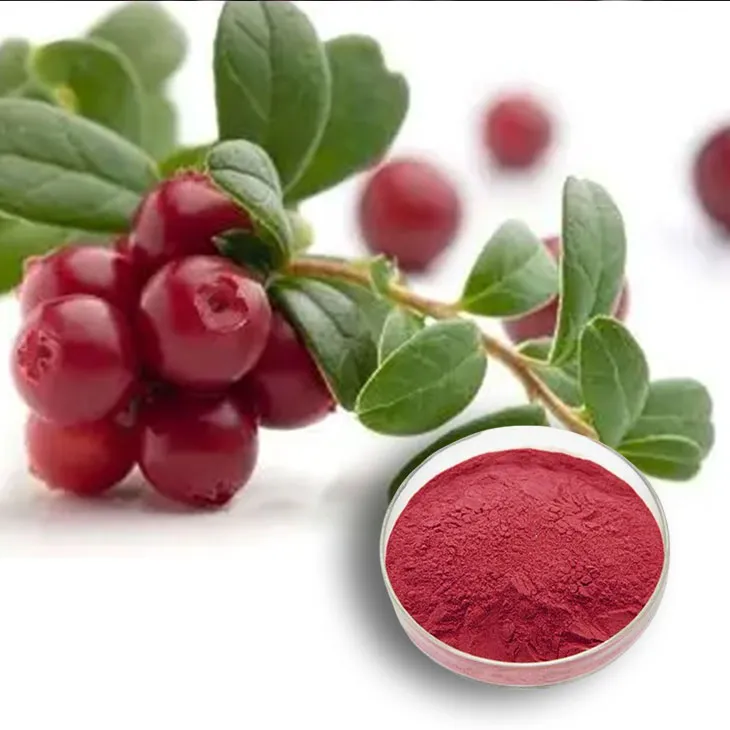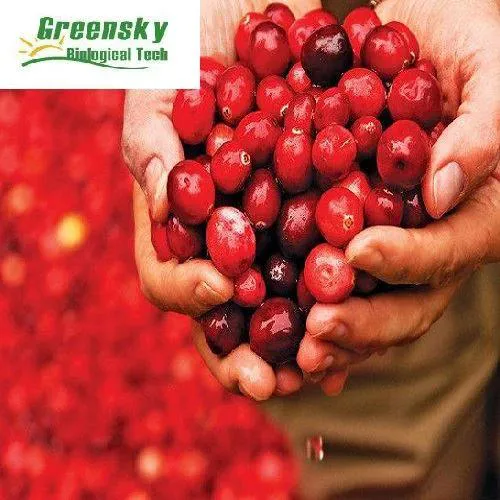- 0086-571-85302990
- sales@greenskybio.com
The process of extracting cranberry anthocyanins from cranberry extract.
2024-11-30

1. Introduction
Cranberries are well - known for their rich nutritional content, and among their valuable components, cranberry anthocyanins stand out. These anthocyanins are not only responsible for the vibrant color of cranberries but also possess numerous health benefits. They have antioxidant, anti - inflammatory, and anti - microbial properties, making them highly desirable in various applications such as the food, pharmaceutical, and cosmetic industries. The extraction of cranberry anthocyanins from Cranberry Extract is a complex yet crucial process that requires careful consideration of multiple factors. This article will provide a comprehensive overview of this extraction process.

2. Raw Material Preparation
The quality of the Cranberry Extract used as the starting material significantly influences the success of the anthocyanin extraction process.
2.1. Selection of Cranberries
Only high - quality cranberries should be selected for the production of Cranberry Extract. Factors such as the variety of cranberries, their ripeness, and the absence of diseases or pests are crucial. Fresh and fully ripe cranberries are preferred as they contain a higher concentration of anthocyanins. Different cranberry varieties may also vary in their anthocyanin content and composition, so choosing the appropriate variety is essential.
2.2. Production of Cranberry Extract
Before the extraction of anthocyanins, cranberry extract needs to be obtained. This can be achieved through various methods, such as solvent extraction or mechanical pressing. Solvent extraction typically involves the use of solvents like water or ethanol to dissolve the active compounds from cranberries. Mechanical pressing, on the other hand, physically squeezes the cranberries to obtain the juice, which can then be further processed to obtain the extract. The resulting cranberry extract should be of high quality, with a relatively high concentration of anthocyanins and minimal impurities.

3. Solvent Selection
The choice of solvent is vital for efficient extraction of cranberry anthocyanins from the extract.
3.1. Aqueous - Alcohol Mixtures
Aqueous - alcohol mixtures, such as ethanol - water solutions, are commonly used solvents for anthocyanin extraction. Ethanol is a suitable solvent as it can effectively dissolve anthocyanins while also being relatively safe and easy to handle. The ratio of ethanol to water in the mixture can influence the extraction efficiency. A higher ethanol concentration may result in better extraction of anthocyanins, but it may also increase the cost and potential environmental impact. Typically, a ratio of around 50 - 70% ethanol in water is often used. This balance allows for efficient extraction while also considering factors such as cost and safety.
3.2. Other Solvents
While aqueous - alcohol mixtures are popular, other solvents have also been explored. For example, acidified solvents can sometimes be used to improve the extraction of anthocyanins. Acids such as citric acid or hydrochloric acid can be added to the solvent to adjust the pH. This can help in breaking down the cell walls of cranberries more effectively, thereby increasing the release of anthocyanins. However, the use of acidified solvents requires careful control of the pH to avoid degradation of the anthocyanins. Additionally, some researchers have investigated the use of supercritical fluids, such as supercritical carbon dioxide, for anthocyanin extraction. Although this method has some advantages, such as being more environmentally friendly, it also requires more complex equipment and higher operating costs.

4. Extraction Techniques
Once the appropriate solvent is selected, various extraction techniques can be employed to obtain cranberry anthocyanins from the extract.
4.1. Maceration
Maceration is one of the simplest and most commonly used extraction techniques. In this method, the cranberry extract is mixed with the selected solvent and allowed to stand for a certain period of time, usually several hours to days. During this time, the solvent penetrates the plant material in the extract, dissolving the anthocyanins. The mixture is often stirred occasionally to ensure better contact between the solvent and the extract. After the maceration period, the resulting solution contains the dissolved anthocyanins along with other dissolved substances from the extract. Maceration is a relatively low - cost and easy - to - perform method, but it may require a longer extraction time compared to other techniques.
4.2. Ultrasonic - Assisted Extraction
Ultrasonic - assisted extraction is a more advanced technique that utilizes ultrasonic waves to enhance the extraction process. When ultrasonic waves are applied to the mixture of cranberry extract and solvent, they create cavitation bubbles. These bubbles collapse violently, generating high - pressure and high - temperature micro - environments. This helps in breaking down the cell walls of the cranberries more effectively, increasing the release of anthocyanins. Ultrasonic - assisted extraction can significantly reduce the extraction time compared to traditional maceration. It also has the potential to improve the extraction yield. However, this method requires specialized ultrasonic equipment, which may increase the cost of the extraction process.
4.3. Other Extraction Techniques
In addition to maceration and ultrasonic - assisted extraction, other techniques such as microwave - assisted extraction and supercritical fluid extraction have also been studied for cranberry anthocyanin extraction. Microwave - assisted extraction uses microwave energy to heat the mixture of extract and solvent, which can also enhance the extraction process by increasing the mass transfer rate. Supercritical fluid extraction, as mentioned earlier, has the advantage of being more environmentally friendly, but it also has higher technical requirements and costs. Each of these techniques has its own advantages and disadvantages, and the choice of technique depends on various factors such as the scale of production, cost, and desired extraction efficiency.

5. Purification Steps
After the extraction process, the resulting solution contains not only cranberry anthocyanins but also other substances from the cranberry extract and the solvent. Therefore, purification steps are necessary to obtain pure cranberry anthocyanins.
5.1. Filtration
Filtration is the first step in the purification process. The extracted solution is passed through a filter to remove large particles such as plant debris and undissolved solids. This can be achieved using various types of filters, such as filter papers, membrane filters, or filter cartridges. Filtration helps in clarifying the solution and removing some of the impurities, but it may not be sufficient to remove all the unwanted substances. For example, small - molecule impurities may still remain in the solution after filtration.
5.2. Chromatography
Chromatography is a more advanced purification technique that can separate cranberry anthocyanins from other substances based on their different physicochemical properties. There are several types of chromatography that can be used for this purpose, such as column chromatography, high - performance liquid chromatography (HPLC), and thin - layer chromatography (TLC). Column chromatography involves passing the filtered solution through a column filled with a stationary phase. Different substances in the solution will interact differently with the stationary phase, resulting in their separation. HPLC is a more sophisticated form of chromatography that can provide high - resolution separation and accurate quantification of anthocyanins. TLC is a simpler and relatively inexpensive method that can be used for preliminary analysis and purification. Chromatography is a powerful tool for obtaining highly pure cranberry anthocyanins, but it also requires more complex equipment and skilled operators.
6. Conclusion
The process of extracting cranberry anthocyanins from cranberry extract is a complex and multi - step process. It involves careful preparation of raw materials, selection of appropriate solvents, application of efficient extraction techniques, and purification steps to obtain pure anthocyanins. Each step in the process is crucial and can influence the final quality and yield of the cranberry anthocyanins. With the increasing demand for natural and healthy products, the extraction of cranberry anthocyanins has great potential for further development. Future research may focus on improving the extraction efficiency, reducing costs, and exploring new applications for these valuable compounds.
FAQ:
What are the main health benefits of cranberry anthocyanins?
Cranberry anthocyanins are known for several health benefits. They have antioxidant properties, which can help in combating oxidative stress in the body. They may also play a role in urinary tract health, potentially preventing urinary tract infections by inhibiting the adhesion of bacteria. Additionally, some studies suggest that they could have anti - inflammatory effects and may contribute to cardiovascular health.
Why is raw material preparation important in the extraction of cranberry anthocyanins?
Raw material preparation is crucial in the extraction of cranberry anthocyanins. High - quality cranberry extract serves as the starting point for a successful extraction. It ensures that the cranberries used are of good quality, free from contaminants and spoilage. This helps in obtaining a consistent and reliable source of anthocyanins. Moreover, proper preparation can enhance the extraction efficiency by ensuring that the active compounds are more accessible during the extraction process.
What are the advantages of using aqueous - alcohol mixtures as solvents for extraction?
Aqueous - alcohol mixtures are advantageous solvents for extracting cranberry anthocyanins. These mixtures can effectively dissolve anthocyanins while also having properties that can penetrate the plant material well. Alcohol helps in breaking down cell walls and membranes, making the anthocyanins more accessible. The water component in the mixture is important as anthocyanins are water - soluble to some extent. Additionally, aqueous - alcohol mixtures are relatively safe and can be easily removed during the purification steps.
How does ultrasonic - assisted extraction work in the process?
Ultrasonic - assisted extraction works by using ultrasonic waves. These waves create cavitation bubbles in the solvent. When these bubbles collapse, they generate intense local forces and high - temperature and - pressure regions. These effects can disrupt the cell walls of the cranberry extract more effectively than traditional extraction methods. As a result, the anthocyanins are released more easily into the solvent, increasing the extraction efficiency.
What is the role of chromatography in purifying cranberry anthocyanins?
Chromatography is a key step in purifying cranberry anthocyanins. It is a separation technique that can separate different components in a mixture based on their chemical and physical properties. In the case of cranberry anthocyanins, chromatography can separate anthocyanins from other impurities such as sugars, proteins, and other plant compounds. Different types of chromatography, like high - performance liquid chromatography (HPLC), can be used to achieve high - purity anthocyanin extracts.
Related literature
- Extraction and Characterization of Anthocyanins from Cranberries"
- "Optimization of Cranberry Anthocyanin Extraction: A Review"
- "The Health - Promoting Properties of Cranberry Anthocyanins: A Comprehensive Study"
- ▶ Hesperidin
- ▶ Citrus Bioflavonoids
- ▶ Plant Extract
- ▶ lycopene
- ▶ Diosmin
- ▶ Grape seed extract
- ▶ Sea buckthorn Juice Powder
- ▶ Fruit Juice Powder
- ▶ Hops Extract
- ▶ Artichoke Extract
- ▶ Mushroom extract
- ▶ Astaxanthin
- ▶ Green Tea Extract
- ▶ Curcumin
- ▶ Horse Chestnut Extract
- ▶ Other Product
- ▶ Boswellia Serrata Extract
- ▶ Resveratrol
- ▶ Marigold Extract
- ▶ Grape Leaf Extract
- ▶ New Product
- ▶ Aminolevulinic acid
- ▶ Cranberry Extract
- ▶ Red Yeast Rice
- ▶ Red Wine Extract
-
Hericium erinaceus extract powder
2024-11-30
-
Sugarcane Extract
2024-11-30
-
Rose Hip Extract
2024-11-30
-
Peppermint Oil
2024-11-30
-
Diosmin
2024-11-30
-
Astaxanthin
2024-11-30
-
Hops Extract
2024-11-30
-
Dandelion Root Extract
2024-11-30
-
Artichoke Extract
2024-11-30
-
Wheat Germ Extract
2024-11-30





















